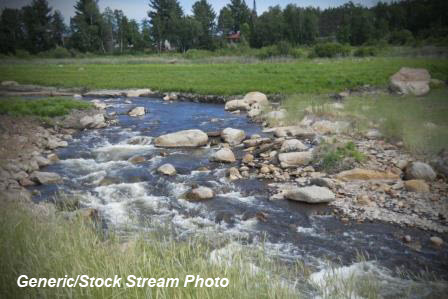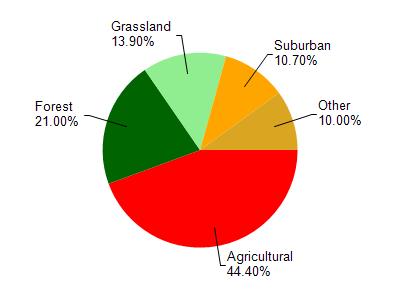
8.50 Miles
0 - 8.50
Cool-Cold Mainstem, Cool-Warm Mainstem
2025
Poor
High Phosphorus Levels
Total Phosphorus
Chippewa
No
No
Yes
Fish and Aquatic Life
Overview
The Class I portion of Duncan Creek, the headwater area, is classified as an outstanding resource
water (ORW), which requires any new point source discharge to have effluent limits as stringent as
the water quality found in the creek. This area has few limiting factors or pollutant sources except a
few small barnyards near the streambank. The extreme upper reach of Duncan Creek near New
Auburn is a State Fishery Area. Below Lake Como, which is the first Duncan Creek impoundment
at Bloomer, the creek is a warm water fishery, although brown trout are often found in this section
(Kurz). Limiting factors and pollutants in this reach include streambank erosion due to cattle access,
sedimentation, and organic and nutrient loading from runoff and point sources of pollution. With
pollutant sources controlled and fish stocking, this stream reach could become a Class 11 trout
fishery. The lower five miles of Duncan Creek are limited by elevated stream temperatures,
streambank erosion, sedimentation, and organic and nutrient loading. This portion of Duncan
Creek has the potential to become a Class I1 trout stream if temperatures can be lowered (Schreiber
June, 1992).
The Bloomer wastewater treatment plant discharges to Duncan Creek about one mile below
Como Dam. To allow more accurate use of existing stream data when evaluating limits for the
Bloomer plant, district staff need additional data (LaLiberte 1994).
Bloomer's effluent increases phosphorus and nitrogen concentrations in Duncan Creek by 131
percent and 64 percent, respectively. This discharge likely aggravates water quality problems in the
downstream impoundments. The Bloomer facility currently discharges total phosphorus at a
concentration of 12 mg/l. Administrative Rule NR.217 will require phosphorus treatment to 1 mg/l
(Simonson) .
Date 1996
Author Aquatic Biologist
Impaired Waters
Duncan Creek from its mouth to CTH B (miles 0 to 8.5) was put on the impaired waters list in 2014 for phosphorus. Evaluations in 2016 and 2018 confirmed the phosphorus impairment.
Duncan Creek from CTH B to the northernmost crossing of CTH Q (miles 8.5 to 14.84) was put on the impaired waters list in 2014 for phosphorus. This water was evaluated for biology in 2018 and 2020 and fish communities were found to be in good health.
Duncan Creek from the northernmost crossing of CTH Q to Lake Como (miles 14.84 to 20.72) was put on the impaired waters list in 2014 for phosphorus. Evaluations in 2016 and 2018 confirmed the phosphorus impairment.
Duncan Creek from Lake Como to its headwaters (miles 22.48 to 30.7) was evaluated for biology in the 2014, 2018, and 2020; communities were in in good condition. This segment of the stream is on the Healthy Waters List.
Date 2022
Author Ashley Beranek
Condition
Wisconsin has over 84,000 miles of streams, 15,000 lakes and milllions of acres of wetlands. Assessing the condition of this vast amount of water is challenging. The state's water monitoring program uses a media-based, cross-program approach to analyze water condition. An updated monitoring strategy (2015-2020) is now available. Compliance with Clean Water Act fishable, swimmable standards are located in the Executive Summary of Water Condition in 2018. See also the 'monitoring and projects' tab.
Reports
Recommendations
Nine Key Element Plan
Duncan Creek PWS Plan - Nine Key Element Plan - The Duncan Creek Priority Watershed Project plan assesses the nonpoint sources of pollution in the Duncan Creek Watershed and guides the implementation of nonpoint source control measures. These control measures are needed to meet specific water resource objectives for Duncan Creek and its tributaries.
Management Goals
Wisconsin's Water Quality Standards provide qualitative and quantitative goals for waters that are protective of Fishable, Swimmable conditions [Learn more]. Waters that do not meet water quality standards are considered impaired and restoration actions are planned and carried out until the water is once again fishable and swimmable
Management goals can include creation or implementation of a Total Maximum Daily Load analysis, a Nine Key Element Plan, or other restoration work, education and outreach and more. If specific recommendations exist for this water, they will be displayed below online.
Monitoring
Monitoring the condition of a river, stream, or lake includes gathering physical, chemical, biological, and habitat data. Comprehensive studies often gather all these parameters in great detail, while lighter assessment events will involve sampling physical, chemical and biological data such as macroinvertebrates. Aquatic macroinvertebrates and fish communities integrate watershed or catchment condition, providing great insight into overall ecosystem health. Chemical and habitat parameters tell researchers more about human induced problems including contaminated runoff, point source dischargers, or habitat issues that foster or limit the potential of aquatic communities to thrive in a given area. Wisconsin's Water Monitoring Strategy was recenty updated.
Grants and Management Projects
Monitoring Projects
| WBIC | Official Waterbody Name | Station ID | Station Name | Earliest Fieldwork Date | Latest Fieldwork Date | View Station | View Data |
|---|
| 2152600 | Chippewa Falls Flowage 5555 | 093073 | Chippewa River - Chip Falls Tailrace - Chip Falls Tailrace | 7/7/1988 | 10/6/1988 | Map | Data |
| 2150600 | Duncan Creek | 10043084 | Duncan Creek at Bridgewater Street | 6/12/2014 | 1/1/2015 | Map | Data |
| 2150600 | Duncan Creek | 093040 | Duncan Creek - Cth B R Mi 6.9 | | | Map | Data |
| 2150600 | Duncan Creek | 10022385 | Duncan Creek - Irvine Park Drive | 6/30/2003 | 9/15/2003 | Map | Data |
| 2152600 | Chippewa Falls Flowage 5555 | 10001051 | Chippewa Falls Flowage | 8/29/2000 | 6/24/2025 | Map | Data |
| 2150600 | Duncan Creek | 10014581 | Duncan Creek - Spring Street (Chippewa Falls) | 10/18/1990 | 1/1/2015 | Map | Data |
| 2150600 | Duncan Creek | 10018050 | Duncan Creek/Glen Lock Lake -- Access | 5/26/2011 | 8/20/2022 | Map | Data |
| 2150800 | Star Lake | 093021 | Duncan Creek - Lienenkugal Brewing Co Chip Fall | | | Map | Data |
| 2150600 | Duncan Creek | 093038 | Duncan Creek - Sth 124 R Mi 0.0 | | | Map | Data |
| 2150600 | Duncan Creek | 10022387 | Duncan Creek - 129th St | | | Map | Data |
| 2150800 | Star Lake | 10043084 | Duncan Creek at Bridgewater Street | 6/12/2014 | 1/1/2015 | Map | Data |
| 2150800 | Star Lake | 10016027 | Duncan Creek - 50 Ft Above Scenic Drive Bridge Inirvine Park In Chippewa Falls. Below Glenloch Lake | 10/17/1990 | 1/1/2015 | Map | Data |
| 2150600 | Duncan Creek | 10040487 | Duncan Creek near Leinie's Lodge where STH 178 turns N | 7/7/2003 | 9/22/2003 | Map | Data |
| 2150600 | Duncan Creek | 10055980 | Duncan Creek - Near 129th St. | | | Map | Data |
| 2150600 | Duncan Creek | 093039 | Duncan Creek - Cth S R Mi 3.2 | | | Map | Data |
| 2150600 | Duncan Creek | 10016222 | Duncan Creek - 10 Yds Below Bridge On Cth Q.Downstream Of Tilden Millpond | 10/17/1990 | 1/1/2015 | Map | Data |
| 2150600 | Duncan Creek | 10020906 | Duncan Creek At Columbia St. | | | Map | Data |
| 2150600 | Duncan Creek | 093169 | Duncan Creek - Irving Park | 7/23/1991 | 10/30/2019 | Map | Data |
|

Watershed Characteristics
Duncan Creek is located in the Duncan Creek watershed which is 191.44 mi². Land use in the watershed is primarily agricultural (44.40%), forest (21%) and a mix of grassland (13.90%) and other uses (20.70%). This watershed has 270.37 stream miles, 185.45 lake acres and 6,971.50 wetland acres.
Nonpoint Source Characteristics
This watershed is ranked Not Available for runoff impacts on streams, Not Available for runoff impacts on lakes and High for runoff impacts on groundwater and therefore has an overall rank of High. This value can be used in ranking the watershed or individual waterbodies for grant funding under state and county programs.However, all waters are affected by diffuse pollutant sources regardless of initial water quality. Applications for specific runoff projects under state or county grant programs may be pursued. For more information, go to surface water program grants.
Duncan Creek is considered a Cool-Cold Mainstem, Cool-Warm Mainstem under the state's Natural Community Determinations.
Natural communities (stream and lake natural communities) represent model results and DNR staff valiation processes that confirm or update predicted conditions based on flow and temperature modeling from historic and current landscape features and related variables. Predicated flow and temperatures for waters are associated predicated fish assemblages (communities). Biologists evaluate the model results against current survey data to determine if the modeled results are corect and whether biological indicators show water quaity degradation. This analysis is a core component of the state's resource management framework. Wisconsin's Riverine Natural Communities.
Cool (Cold-Transition) Mainstem streams are moderate-to-large but still wadeable perennial streams with cold to cool summer temperatures. Coldwater fishes are common to uncommon, transitional fishes are abundant to common, and warm water fishes are uncommon to absent. Headwater species are common to absent,
mainstem species are abundant to common, and river species are common to absent.